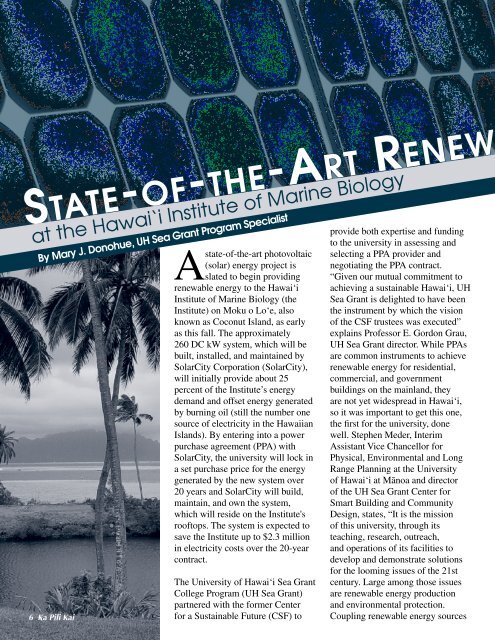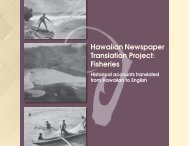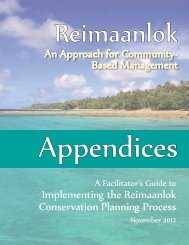Ka Pili Kai Summer 2012 - Sea Grant College Program
Ka Pili Kai Summer 2012 - Sea Grant College Program
Ka Pili Kai Summer 2012 - Sea Grant College Program
- No tags were found...
You also want an ePaper? Increase the reach of your titles
YUMPU automatically turns print PDFs into web optimized ePapers that Google loves.
Back to TOCState-of-the-Art Renewable Energy Projectat the Hawai‘i Institute of Marine BiologyAstate-of-the-art photovoltaic(solar) energy project isslated to begin providingrenewable energy to the Hawai‘iInstitute of Marine Biology (theInstitute) on Moku o Lo‘e, alsoknown as Coconut Island, as earlyas this fall. The approximately260 DC kW system, which will bebuilt, installed, and maintained bySolarCity Corporation (SolarCity),will initially provide about 25percent of the Institute’s energydemand and offset energy generatedby burning oil (still the number onesource of electricity in the HawaiianIslands). By entering into a powerpurchase agreement (PPA) withSolarCity, the university will lock ina set purchase price for the energygenerated by the new system over20 years and SolarCity will build,maintain, and own the system,which will reside on the Institute'srooftops. The system is expected tosave the Institute up to $2.3 millionin electricity costs over the 20-yearcontract.By Mary J. Donohue, UH <strong>Sea</strong> <strong>Grant</strong> <strong>Program</strong> Specialistprovide both expertise and fundingto the university in assessing andselecting a PPA provider andnegotiating the PPA contract.“Given our mutual commitment toachieving a sustainable Hawai‘i, UH<strong>Sea</strong> <strong>Grant</strong> is delighted to have beenthe instrument by which the visionof the CSF trustees was executed”explains Professor E. Gordon Grau,UH <strong>Sea</strong> <strong>Grant</strong> director. While PPAsare common instruments to achieverenewable energy for residential,commercial, and governmentbuildings on the mainland, theyare not yet widespread in Hawai‘i,so it was important to get this one,the first for the university, donewell. Stephen Meder, InterimAssistant Vice Chancellor forPhysical, Environmental and LongRange Planning at the Universityof Hawai‘i at Mänoa and directorof the UH <strong>Sea</strong> <strong>Grant</strong> Center forSmart Building and CommunityDesign, states, “It is the missionof this university, through itsteaching, research, outreach,and operations of its facilities todevelop and demonstrate solutionsfor the looming issues of the 21stcentury. Large among those issuesare renewable energy productionand environmental protection.with research aimed at protectingand preserving marine resourcesand ecosystems is a holistic steptowards moving Coconut Islandspecifically, and the HawaiianIslands by extension, toward asustainable future.”Power purchase agreements forrenewable energy systems allowthose who would like to benefitfrom solar energy, but who donot have the funds or do not wishto invest in a system outright, toessentially rent out their rooftops torenewable energy companies and“buy back” the energy producedfrom the systems installed ontheir own buildings. Renewableenergy companies, with extensivein-house expertise and access tocapital investment, design, install,“It is the mission of this university, throughits teaching, research, outreach, andoperations of its facilities to developand demonstrate solutions for thelooming issues of the 21st century.”View of the Pelagic Fisheries Laboratory at the Institute. Research laboratories are among the mostenergy and water intensive buildings to operate on any university campus and these challenges areintensified in the sensitive environmental locations in which most marine laboratories are sited.Ultimately, the goal for the Institute is to be energy and water independent and waste-zero; anambitious but worthwhile goal that will serve as a model for other university buildings.View of the National Science Foundation Laboratoryat the Institute. Photovoltaic panels will be placedon existing rooftops, generating renewable energyexpected to provide between 25 and 50 percent of theInstitute’s energy needs.run, and maintain the systemsover a set contract period, often20 years. The Institute will buy allof the energy produced on theirrooftops by the SolarCity system ata set price per kWh, significantlybelow the current market pricefor traditional (petroleum-based)electricity production. Knowingwith certainty the price for thisenergy over the 20-year agreementallows the Institute to budget andplan with confidence, regardlessof fluctuations in future oil andelectricity costs. SolarCity is alsoable to invest in the system withconfidence, knowing they havea buyer for the energy producedfor at least 20 years. At the end ofthe 20-year contract period, theuniversity may elect to purchasethe system ownership outright,remove the system, or continue thePPA arrangement with SolarCity.Marine institutes and theirassociated laboratories are theheart of our nation’s coastal andmarine research, conservation,The University of Hawai‘i <strong>Sea</strong> <strong>Grant</strong><strong>College</strong> <strong>Program</strong> (UH <strong>Sea</strong> <strong>Grant</strong>)partnered with the former Centerand management efforts but are6 <strong>Ka</strong> <strong>Pili</strong> <strong>Ka</strong>i for a Sustainable Future (CSF) to Coupling renewable energy sources13 <strong>Ka</strong> 7 <strong>Ka</strong> <strong>Pili</strong> <strong>Pili</strong> <strong>Ka</strong>i <strong>Ka</strong>i
















